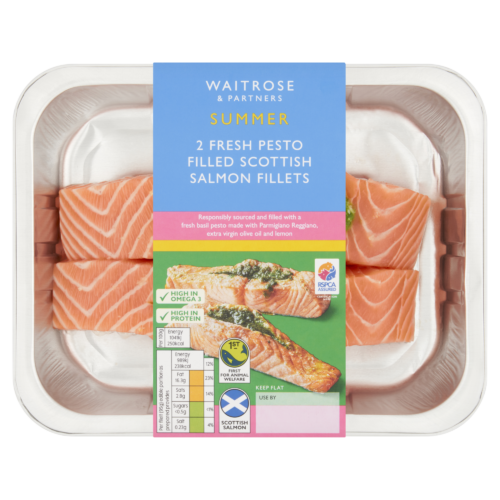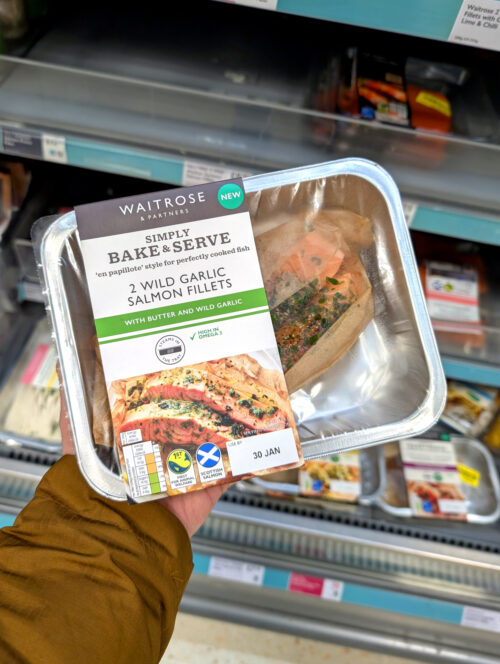
Aquascot launches two new Scottish salmon products at Waitrose
Simon Fowler is a family-oriented man, avid beekeeper and antique collector. Born in Thailand and brought up in Central Africa, he studied Biology at Portsmouth University before starting his thirty-four year career at the John Lewis Partnership. He is now semi-retired and settled in North Liverpool, where he looks after his son, a fervent Everton supporter, with his husband, Cathal.
Exciting, I would say, for all sorts of reasons. First and foremost, because the business is growing well, showing lots of signs of success and has weathered what the world has seen as an extraordinary period of time through the pandemic. For partners to have turned Aquascot into even more of a success story during a world-pandemic is an exceptional feat. It demonstrates the ‘Power of Partnership’ and the power of people working together in an employee-owned (EO) business.
Secondly, because we’re just beginning on a journey towards a new five-year strategy, called ‘Aquafuture’, which partners will hear more about over the course of the coming months. It lays the foundations for the next five years of business growth, drawing from the competitive market we operate in, drawing from feedback we’ve had from partners, drawing from feedback we’ve had from the Partnership Council, and feedback from our key customer, Waitrose.
Thirdly, because as well as chairing the Aquascot Board, I’m also a director of the Aquascot Trust, which means I get to play a role in helping to shape the direction of the Trust company along with the part Aquascot plays in ensuring the Trust can deliver on all of its plans.
And I suppose last, but certainly not least, because I’m arriving at a time when the values and principles which have been put together with input from partners over many months are really starting to come to life. We’re starting to use these much more in our communications, and in the way in which we are measuring both partner performance and business performance.
So overall, I feel extraordinarily lucky to be joining Aquascot at such a pivotal time. It provides me with a huge amount of stimulation to be able to support the organisation to deliver on its future potential.

Simon Fowler (right), when Director of Communications of the John Lewis Partnership, with Deb Oxley (CEO of the EOA), Richard Marr (Chief Operating Officer of The eaga Trust) and Sharon Bowles (Inquiry Chair Baroness)
A number of things really. Primarily
the employee-ownership nature of the organisation. I was Chair of the Employee
Ownership Association (EOA) for 10 years, and so both with my EOA hat on as
well as my role within the John Lewis Partnership (JLP), I was very aware of
all the work that Aquascot was doing.
My knowledge of the business secondarily. I came into contact with Dennis (Overton) through the work he is doing across much of Scotland – he’s such an entrepreneur in his own right – so when the opportunity came along to put my hat in the ring for this role, I was delighted, I didn’t have to think twice. I then went through a rigorous interview process before being officially hired!
I suppose there’s probably also a
third plank to my interest in Aquascot, which is a love of the natural world,
an interest in biological sciences, that runs through me and led me to study
Biology at Portsmouth University. I’m a honeybee farmer as well. I took up
beekeeping more seriously since I retired from the JLP back in 2020, and I’ve now
got plenty of hives across the North West. I’ve even set up my own small
beekeeping business with two fellow beekeepers and we’ve just been asked to
place some of our beehives on top of the iconic Liver Building in Liverpool! The
idea of being kind to nature, working with nature and not against it, with
farming practices, is something that runs very deep in me. All of these things come
together in Aquascot. We feed the nation in a healthy, kind and considerate
way.
When I worked in the JLP, the
things that always drew me to it and kept me there for 34 years were its
purpose, principles and values all enshrined in a Constitution. And at the
heart of this Constitution and contained in the ultimate purpose of JLP, is the
happiness of all of its members. I think any EO business ought to be striving
for the same outcome, the happiness of all the partners that work within the
business. That should be the ultimate goal – the happiness and fulfilment made
possible in a successful business.
The three things that stand out for most EO organisations in my view are also recognised in the JLP Constitution – Gain, Knowledge, and Power.
Gain is all about the sense of fulfilment possible when working in a EO business; helping to run the business, helping to shape the future of the business and handing the business over to the next generation of partners in better shape. Gain is also about sharing in the success of the business, being able to draw an income from an organisation that we co-own and an opportunity to share in its profits.
In my view, Knowledge sits at the heart of achieving engagement in an EO company. The words ‘knowledge’, ‘information’ and ‘communication’ are often used interchangeably but signify quite different things. Information is giving out (of facts), whilst communication is getting through (emotionally), it helps build ‘stickiness’. Knowledge is the result of the chemistry that happens between communication and experience, whilst engagement is the result of effective knowledge building – it enables choice and control and delivers the benefit of both non-discretionary and discretionary effort so effective in EO firms. Knowledge enables resilience and good judgement, whilst engagement fuels the EO model.
It’s important that partners feel that Power is shared in an EO business – the opportunity to be heard and to influence change is so important. This is why our democratic structure and elected Partnership Councillors are so important for the key role they play. Equally important is building a culture of empowerment, where partners really feel they can make a difference when they come to work.
When these three ingredients work
in harmony, I believe they contribute immensely to partner happiness.

Simon Fowler presenting at the EOA Summer Dinner in the House of Commons
I started my career as a Graduate Trainee, beginning my first placement at Peter Jones (PJ) in Sloane Square. PJ is the only branch of the JLP that has a different name. The main reason for this is because it’s the birthplace of the JLP and so has a very special place in the heart of the JLP. Indeed. In the early 1900s, John Lewis bought the business from a faltering milliner called Peter Jones and started to put the first ideas of EO into practice there.
I then moved around the country with the first half of my career spent largely in retail operational roles. I became the youngest branch Managing Director (MD) in John Lewis, Cambridge, moving onto a number of other MD roles before returning to PJ as MD before taking up the role of MD, John Lewis Oxford Street, the Central London flagship shop. John Lewis Oxford Street is a huge business employing 3,000 partners and turning over half a billion pounds per annum. It’s like running a small town and really important to harness employee-ownership to get the best out of such an important operation.
The second half of my career was spent in strategic Head Office roles. Based in Victoria, I started as Head of Customer Service for John Lewis, leading the customer service strategy for the business. I introduced an initiative called the ‘ABC of selling’. This recognised the importance of personalisation during the three key stages of selling – Acknowledging customers, Building the sale and Closing the sale. The initiative concluded by launching the ‘DEF of selling’ – Delivering Everyday with Feeling to enhance the sense of personalisation which is the hallmark of the John Lewis service experience.
I later took on the role of Partnership Registrar. This is a role appointed by the Chairman and responsible for ensuring the JLP Constitution, its purpose and values, are being upheld by the Executive Team and senior leaders. I was also responsible for democratic vitality and ensuring partner opinion was being effectively surfaced to influence the direction and management of the business.
My most recent role in JLP was as
Group Director of Communications. Here I was responsible for internal
communications for 88,000 partners, external media communications with
journalists and the media, corporate affairs and our relationships with No 10
and Westminster, and the Gazette which is the world’s longest running in-house
magazine. In many ways I was responsible for knowledge and engagement.
What I’ve seen of Aquascot communications, internally and externally looks good. Drafting communications for a relatively small team of partners, might at first sight appear easier than for 88,000 partners. However, the drive for clarity, focus and relevance is equally important. It could be easy to fall into the trap of thinking it’s a relatively small team of partners, and therefore it’s easier for communications to flow, but that would be a mistake.
At Aquascot we have some very important messages to land with partners and these require equally careful thought and planning. We have to create compelling content in easily processed chunks of communication which flow through easy to access channels. We’ve then got to translate this into the languages spoken by partners, recognising that our communications have to be pitched correctly to ensure everyone both gets the message and understands what that message means for them.
Partners are also working in very different environments, from production lines to offices, and so will have different opportunities to receive communications and absorb messages. In this modern world, we have to think about modern ways in which we can evolve our communications constantly to ensure that they’re getting to partners in the best possible way, based on where they’re working and how they’re working and what access they have to communication tools.
Interviewed by: Justine Fourny (Category & Marketing Officer)

Aquascot launches two new Scottish salmon products at Waitrose

Introducing Our New Summer Dish: Fresh Pesto Filled Scottish Salmon Fi...

Aquascot is excited to announce our involvement in the new 'Simply Bak...

Aquascot has appointed Fred Bowden as Chairman of the Aquascot Board, ...